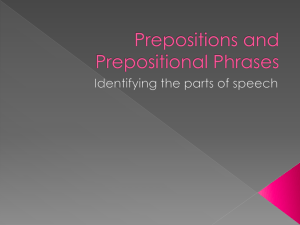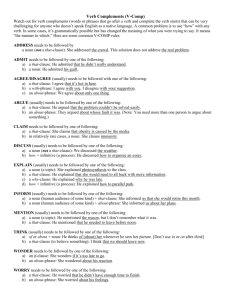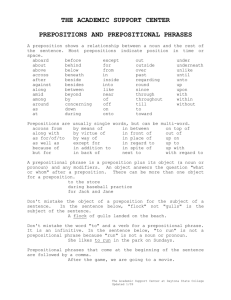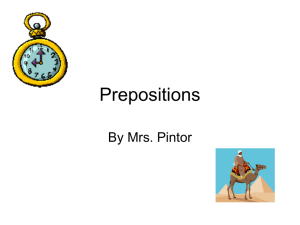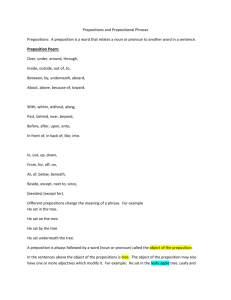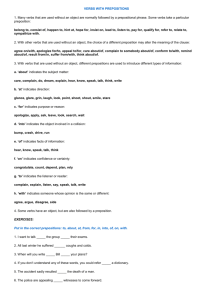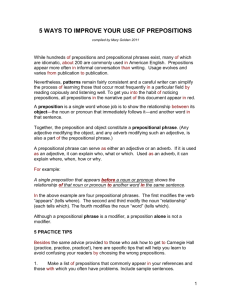Prepositions with that-clause complements in tagged corpora, with a
advertisement
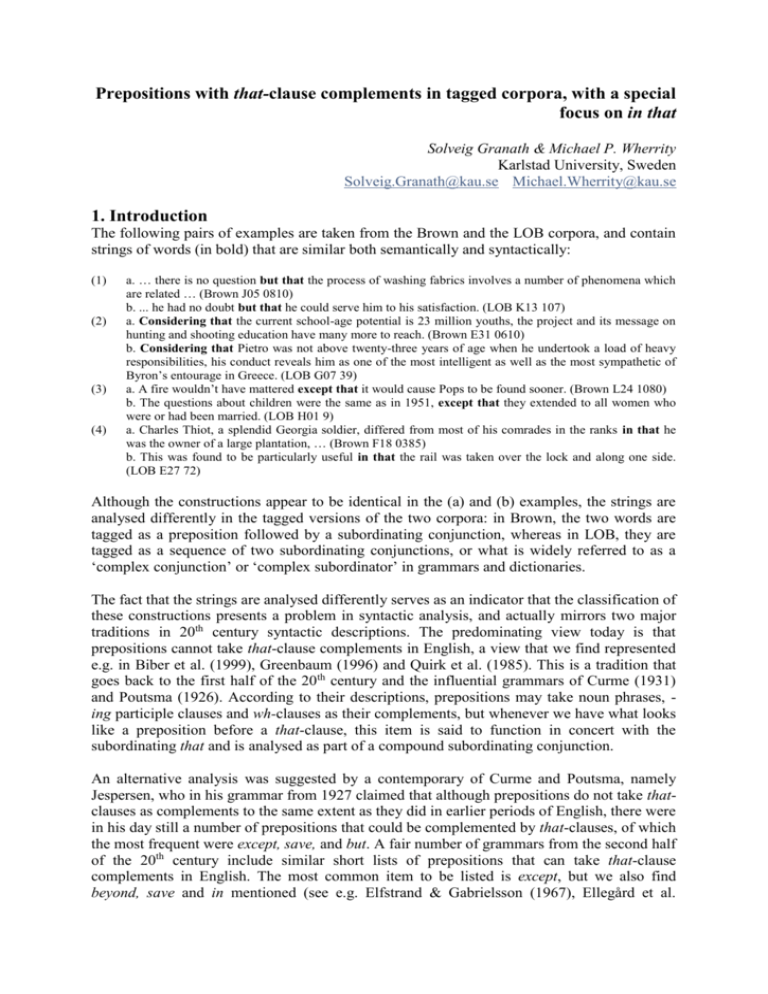
Prepositions with that-clause complements in tagged corpora, with a special focus on in that Solveig Granath & Michael P. Wherrity Karlstad University, Sweden Solveig.Granath@kau.se Michael.Wherrity@kau.se 1. Introduction The following pairs of examples are taken from the Brown and the LOB corpora, and contain strings of words (in bold) that are similar both semantically and syntactically: (1) (2) (3) (4) a. … there is no question but that the process of washing fabrics involves a number of phenomena which are related … (Brown J05 0810) b. ... he had no doubt but that he could serve him to his satisfaction. (LOB K13 107) a. Considering that the current school-age potential is 23 million youths, the project and its message on hunting and shooting education have many more to reach. (Brown E31 0610) b. Considering that Pietro was not above twenty-three years of age when he undertook a load of heavy responsibilities, his conduct reveals him as one of the most intelligent as well as the most sympathetic of Byron’s entourage in Greece. (LOB G07 39) a. A fire wouldn’t have mattered except that it would cause Pops to be found sooner. (Brown L24 1080) b. The questions about children were the same as in 1951, except that they extended to all women who were or had been married. (LOB H01 9) a. Charles Thiot, a splendid Georgia soldier, differed from most of his comrades in the ranks in that he was the owner of a large plantation, … (Brown F18 0385) b. This was found to be particularly useful in that the rail was taken over the lock and along one side. (LOB E27 72) Although the constructions appear to be identical in the (a) and (b) examples, the strings are analysed differently in the tagged versions of the two corpora: in Brown, the two words are tagged as a preposition followed by a subordinating conjunction, whereas in LOB, they are tagged as a sequence of two subordinating conjunctions, or what is widely referred to as a ‘complex conjunction’ or ‘complex subordinator’ in grammars and dictionaries. The fact that the strings are analysed differently serves as an indicator that the classification of these constructions presents a problem in syntactic analysis, and actually mirrors two major traditions in 20th century syntactic descriptions. The predominating view today is that prepositions cannot take that-clause complements in English, a view that we find represented e.g. in Biber et al. (1999), Greenbaum (1996) and Quirk et al. (1985). This is a tradition that goes back to the first half of the 20th century and the influential grammars of Curme (1931) and Poutsma (1926). According to their descriptions, prepositions may take noun phrases, ing participle clauses and wh-clauses as their complements, but whenever we have what looks like a preposition before a that-clause, this item is said to function in concert with the subordinating that and is analysed as part of a compound subordinating conjunction. An alternative analysis was suggested by a contemporary of Curme and Poutsma, namely Jespersen, who in his grammar from 1927 claimed that although prepositions do not take thatclauses as complements to the same extent as they did in earlier periods of English, there were in his day still a number of prepositions that could be complemented by that-clauses, of which the most frequent were except, save, and but. A fair number of grammars from the second half of the 20th century include similar short lists of prepositions that can take that-clause complements in English. The most common item to be listed is except, but we also find beyond, save and in mentioned (see e.g. Elfstrand & Gabrielsson (1967), Ellegård et al. (1978), Hudson (1971) and Schibsbye (1970)). What these accounts have in common is that the combination preposition + that-clause is referred to as an exceptional construction, found only with a handful of items. Since the prevailing view is and has been that a that-clause complement of a preposition is the exception rather than the rule, neatening the analysis by reclassifying the items that co-occur with that as the first part of a complex subordinator has appeared to be an economical way of solving the problem, thereby making it possible to generalize the rule that prepositions never take that-clause complements in English. In this paper, we will suggest first, that prepositions do in fact take that-clause complements in English, namely when the preposition is the head of an adjunct in the sentence, and second, that this applies not just to a small handful of (exceptional) items, but can in fact be seen to be completely regular with at least 30-40 prepositions, a number that is too large to be explained away by reanalysis. 2. The syntax and semantics of in that One of the major arguments for classifying these strings as complex subordinators rather than a sequence of preposition + subordinating that is that they are said to be “indivisible both in terms of syntax and in terms of meaning” (Quirk et al. 1985:671). To test this claim, we will take a more detailed look at what can be considered one of the most problematic combinations, namely in that. Dictionaries typically classify in that as an indivisible unit, used ‘to introduce an explanation of a statement’ (Collins Cobuild English Dictionary (1995), MacMillan English Dictionary (2002)). Syntacticians similarly often deny in its prepositional status in combination with that, which is shown e.g. in Pullum (1991:797), who, while admitting that except should be categorised as a preposition before a that-clause, says that in that is best regarded as an idiom, and accords to in no independent status in this construction. At first sight, this may look like a simple and appealing solution. A more detailed look at the syntax and semantics of in will suggest, however, that rather than being simpler, separating this in from other uses of in complicates the analysis. First of all it needs to be recognized that the functional status of the prepositional phrase in the clause is of fundamental importance for the types of complement a preposition can take. When a preposition such as in is the complement of a verb, a noun or an adjective, it is overt when a noun phrase follows (as in (5a)), but regularly omitted before a that-clause (example (5b)), although the preposition will surface in for example pseudo-cleft patterns, like (5c), where it is separated from the that-clause (see Granath 1997): (5) a. “They concurred in the conclusion that … there was strong scientific evidence that the risks of not immunising children were real and in many instances serious.” (The Guardian, 31 July 2003, p. 1) b. They concurred that … there was strong scientific evidence that the risks of not immunising children were real and in many instances serious. b.’ * They concurred in that there was strong scientific evidence that the risks of not immunising children were real and in many instances serious. c. What they concurred in was that there was strong scientific evidence that the risks of not immunising children were real and in many instances serious. On the other hand, when the prepositional phrase functions as an adjunct, as in example (4) above, the preposition must be present, as demonstrated below (for convenience, (4a) is repeated here as (6)): (6) (6)’ Charles Thiot, a splendid Georgia soldier, differed from most of his comrades in the ranks in that he was the owner of a large plantation, … * Charles Thiot, a splendid Georgia soldier, differed from most of his comrades in the ranks that he was the owner of a large plantation, … So, does this mean that we are dealing here with two different lexical items in? Let us begin by looking at the semantics of in in different contexts. 2.1 Cognitive-semantic analysis of in The question of the lexical status of in can be approached from a cognitive-semantic perspective. In his article “Monosemy, Homonymy, and Polysemy”, Wallis Reid of the Columbia School of Linguistics presents a monosemic analysis of the three canonical locative prepositions at, on, and in. According to Reid (2004), each preposition has a basic or core meaning which is partially determined by the value relationships it enters into with the other two. These three prepositions divide up the semantic space LOCATION as follows: at = 0 dimensions; on = more than 0 but less than 3 dimensions; and in = 3 dimensions. These basic meanings are constant, invariable, and operative in all linguistic contexts. Accordingly, at is appropriate for messages involving point-like location, on for those involving planar or linear location, and in for messages of inclusion or containment as illustrated in the following examples: (7) a. He stopped at the traffic light. (point-like location) b. We live on Main Street. (linear location) c. She is standing on the front lawn. (planar location) d. They are in the building. (containment) Although the basic meanings of these three prepositions are grounded in the spatial realm, where they function to indicate relationships among physical entities, they can also function to designate relationships among abstract entities. This extension of function is accomplished conceptually through metaphor; that is, abstract thoughts and notions come to be represented in spatial terms. Reid (2004:109) gives the example he left at my request, where at, whose basic meaning is location in 0 dimensions, is used in reference to a temporally located event, the duration of which is both negligible and insignificant in the context of the message. Turning our attention to in, the item under discussion, we find that it is frequently used to convey abstract messages of containment as in, for example, Maria fell in love, where the subject, Maria, is conceived as completely enveloped by or immersed in an emotional state. In effect, love is conceived as a container. Similarly in we spoke in Gothic, the content of our conversation is conceptualized as encased or even ‘decked-out’ in the linguistic medium Gothic. Here, as in the previous example, the basic meaning of in, 3-dimensional location, is operative and invariant. In the two examples just given, in is followed by a noun phrase complement. In such constructions, the relationship between one or more entities (either specified or unspecified) and the complement of in can be described as a relationship of inclusion where, simply put, one entity is conceptualized as being contained by another. What is true in the case of noun phrase complements of in also holds for -ing participial complements: (8) a. …you need to be self-motivated and comfortable in working by yourself. b. The army, he said, was the merciful incident in shaping future humanitarian operations. The grammatical signal –ing normally suggests that something is in process, i.e., that an entity, mentioned or understood, is involved in an ongoing activity which, for all intents and purposes, may be understood as a container. Accordingly, in (8a) and (8b), the sentence subjects you and army can be regarded as included in or contained by the activities of ‘working’ and ‘shaping’ respectively. Here we note that the preposition in, with the basic meaning of 3-dimensional location, is the least inappropriate of the three canonical locative prepositions for conveying the notion of immersion in an activity. Similarly, it is the least inappropriate choice when the complement of in is a that-clause. When in precedes a that-clause, it has the same semantic function as in cases where it precedes a noun phrase or an -ing participial complement, namely, to suggest a relationship of inclusion in 3-dimensional space. To understand this more clearly, we will begin with a few examples where in does not occur immediately before the that-clause. (9) a. This theme of the Cairo Conference continues to have a heightened significance in the light of the fact that the gap between the rich and the poor of the world is still widening… b. …it was fair and equitable in the light of the circumstance that the original judgment was vacated. c. There is probably little room to cut capital expenditures in view of the fact that they have already been squeezed to a mere 2.4 percent of the GDP. d. In Kosovo the appropriation of the place name is even more questionable in view of the circumstance that a large but undetermined number of Albanian “Kosovos” have emigrated to Kosovo quite recently. In examples (9a) and (9b), a ‘fact’ or ‘circumstance’ expressed by the that-clause can be construed as metaphorically illuminating a visual field in which an entity, i.e., the preceding information, is the focus of attention. In (9c) and (9d), on the other hand, the preceding information is metaphorically set in a visual field viewed from the perspective of a fact or circumstance. What is common to all four of these examples is the idea of ‘focus on an entity’, i.e., on the preceding information contained in the main clause, in a visual field whose boundaries are figuratively delineated by the information in the that-clause. Here ‘light’ and ‘view’ might be regarded as metonymic extensions of a source, i.e., the ‘fact’ or ‘circumstance’ expressed in the that-clause. As such, they function as containers for the information presented in the main clause. Moving on to the in that-clause construction, we suggest that this structure reflects the same underlying principle of conceptual organization as in cases where there is an intervening NP on the order of those discussed. If we test this claim by substituting in that for in NP that in the examples in (9), we find that there is little or no change in the propositional meaning: (9)’ a. The Cairo Conference continues to have a heightened significance in that the gap between the rich and the poor is still widening… b. …it was fair and equitable in that the original judgment was vacated. c. There is probably little room to cut capital expenditures in that they have already been squeezed to a mere 2.4 percent of GDP. d. In Kosovo the appropriation of the place name is even more questionable in that a large but undetermined number of Albanian “Kosovars” have emigrated into Kosovo quite recently. The principal difference between the original examples and the reworded ones is that in the latter, the relationship between the information in the main clause and the information in the that-clause is expressed more abstractly. Here, we suggest that in that represents a conventionalized expression in which the notions evoked by in the light of and in view of are latent. In effect, these notions which inform the underlying conceptual structure are suppressed, as it were, on the surface level. Nevertheless, the implicit conceptualization as a relationship of containment, i.e., one in which the information of the main clause is included in the spotlight or observational field of the that-complement, remains operative. That English speakers are working with basic meanings and are, on some level, aware of the semantic content of prepositions becomes immediately apparent when we substitute on for in before a that-clause: (10) * Goldblatt is unusual among documentary photographers on that he has always sought permission from his subjects. Here, the rendering is unacceptable not because it is grammatically incorrect, but because it presents the hearer with a semantic conflict. On leads the hearer in the direction of constructing a message involving linear or planar location which is incompatible with the that-clause conceptualization (the ‘default’ conceptualization) as a container. Such a semantic conflict is only resolvable through a reconceptualization of the that-clause as a metaphorical line or surface.1 2.2 Syntactic aspects of in + complement Let us now consider some syntactic aspects of the use of in with different types of complement. It has already been mentioned that the preposition in can head both complements and adjuncts in the sentence (see examples (5) and (6) above), and that when it heads a complement, it is typically omitted before a that-clause but retained with other types of complement. It is only when it is the head of an adjunct that in may also take that-clause complements, in addition to other types of complement. Compare the examples in (11), where the context is quite similar regardless of the fact that in (11a), the complement is a noun phrase, in (11b) it is an –ing participle, and in (11c) it is a that-clause: (11) a. Children differ widely in their emotional responses. (Brown J47 0440) b. It differs principally in being shorter (…) (LOB F02 34) c. Strong hands differ from “weak hands” in that their operations are the primary movers. (Brown J39 1160) In all three examples in (11), differ has been highlighted in order to show that in-phrases are often used to introduce an explanation of how something differs from something else. In line with the semantic analysis presented above, adjuncts such as the ones we find here are best labeled ‘circumstantial’, since they provide information about the circumstances under which two or more entities differ. It is notable that such adjuncts are often used in specific contexts. For example, we find them when the matrix clause contains a word that expresses similarity/difference (e.g. resemble, be like, differ, different, difference, rare, unusual, unique), when it includes a word that signals the emotional stance of the speaker/writer (important, interesting, perfect, remarkable, satisfying, useful) or when the circumstance is attributed to a person’s fortune or personal characteristics (fortunate, guilty, lucky, unlucky). Like adjuncts in general, these circumstantial adjuncts are only loosely attached to the rest of the sentence, so that it is not unusual to find them separated from the rest of the sentence by means of a comma, as in (12a). Furthermore, they are mobile in the clause and can also appear in sentence-initial position, as in (12b). (12) a. This applies particularly to children, in that they can become suffocated if polythene bats are placed over their heads. (LOB B10 198) Interestingly, such a reconceptualization may be taking place with view in the expression on this view – which has become current – as opposed to in this view. Here we note that while several instances of the latter occur in the two historical corpora, the Lampeter Corpus and the Corpus of Early English, there are no occurrences of the former. 1 b. In that both cities end their fiscal years on September 30, they could levy taxes for an interim period of nine months, … (Brown H07 1570) As already mentioned, combinations classified as ‘complex subordinators’ are supposedly indivisible both from a semantic and a syntactic point of view. We have just seen that semantically, there is little reason to separate the function of in in these constructions from the way the preposition functions generally in English. What about the claim, then, that in that is indivisible syntactically? One way to test this is to see how the string behaves in coordination. If it were in fact indivisible, we would expect the whole sequence to be repeated after and; what we often find, however, is that in only occurs before the first that-clause, but not before the second. This is a strong indicator that in that is in fact conceptualized as a combination of two different items rather than a unit: (13) The film, … , differs from Tarkovsky’s 1972 film based on the same book, principally in that it is a love story and that it imagines for Kelvin and his dead wife Rheya a past on earth before and leading up to her suicide. (The Guardian, 22 Feb. 2003, p. 28) In this section, we have argued that in has a core meaning which can be identified in both its concrete and more abstract uses, and that syntactically, in may function both as the head of complement and an adjunct in the sentence. It is important to note that it is only as the head of an adjunct that in may be followed by a that-clause. Analyzing the item as belonging to two different word classes (or as being unanalysable in combination with that, as Pullum (1991:797) suggests) is not a very economical way of dealing with the structure. Rather, the most logical way of handling the problem is to classify in as a preposition in all its different uses. 3. Generalising the rule of preposition + that-clauses in adjuncts to other items Let us now briefly return to the other items that were presented in the introduction. As we have seen, but, considering, and except occurring with that-clauses are tagged differently in Brown and LOB, i.e. as prepositions in Brown, and as part of a complex conjunction in LOB. On the other hand, when they, like in, take complements in the form of NPs, -ing participle clauses, and wh-clauses, they are invariably tagged as prepositions. This holds for all the (a) examples in (14) – (16); the problematic cases, as far as tagging goes, are those presented in the (b) examples. (14) a. I have no doubt that under Dr Wright nothing but success could crown the effort. (LOB E12 143) b. So therefore we really knew nothing but that they were telling us that they were taking care of it or looking into it. (CNN World News, 27 Nov. 1995) (15) a. Considering the publicity given to the problem of juvenile delinquency, it is astonishing that so little has been done to remedy its chief cause – the bad home. (LOB G64 167) b. Considering that the current school-age potential is 23 million youths, the project and its message on hunting and shooting education have many more to reach. (Brown E31 0610) (16) a. All classes except the lower joined together. (LOB F28 177) b. The type of presentation of results used in the deterministic process may be used here, except that now the fourth column is redundant. (Brown J79 1580) As was mentioned above, one reason why syntacticians choose to reclassify the items in the (b) examples as part of a complex subordinator is that the number of prepositions that may take a that-clause complement is assumed to be negligible. In the examples presented in (1) – (4) and (14) – (16), we have observed first, how but, considering, except and in are categorized differently in LOB and Brown, and second, how the LOB categorization is based entirely on the FORM of the complement; the MEANING of the item being, for all intents and purposes, ignored. As opposed to this analysis, our line of argument here has been that items that have the same meaning should be categorized in the same way, regardless of the form of their complement. This analysis can also be applied to other items which behave in the same way as the four that were tagged differently in the two million-word corpora. By today’s standards, a million-word corpus must be considered small, and less frequent patterns will often fail to appear, which is why it is necessary to use larger corpora if one wishes to give a fuller account of such patterns. Accordingly, we have consulted other sources and discovered that a number of items that are tagged as prepositions in Brown and LOB also occur with that-clauses. Thus, by using larger corpora in conjunction with the tagged corpora, we have been able to extend the list of such items considerably to include bar, barring, besides, beyond, concerning, excepting, excluding, including, notwithstanding, and save. Compare the use of some of these with nominal complements in examples (17a) – (24a), all tagged as prepositions in both Brown and LOB, with the examples containing the same items with that-clause complements in (17b) – (24b), all culled from large, untagged corpora. Based on the tagging discrepancies between Brown and LOB which we observed in examples (1) – (4), there is no reason to discount the possibility that there would be similar discrepancies, were the examples from the larger corpora to be tagged, that is to say, the (b) examples would be tagged as prepositions in Brown but as part of complex subordinators in LOB. Like in, the items in bold in the (a) and (b) examples have the same semantic content. We therefore propose that they should all be categorized in the same way, namely as prepositions. (17) (18) (19) (20) (21) (22) (23) (24) a. Bar "radio," the book may still be the most popular pleasure: (LOB G70 13) b. As infighting over how to reform current cross-media ownership rules continues, no one has a clear fix on the government’s thinking, bar that No 10 will be heavily involved and it will go to cabinet. (The Guardian, 25 Feb. 2002, p. 4) a. The fact is Italian weather is a humbug and March is (barring Fogs) as bad at Rome as in London. (LOB G06 11) b. I was raised to believe that if a drink has already been purchased and sent to you, the proper thing to do is think of it as a gift, drink it (barring that one has not already over-imbibed) and thank the sender without any further obligation on my part. (The Washington Post, 27Oct. 2004, p. C10) a. They had other topics of conversation, besides their news from courts and fairs, … (Brown G59 1740) b. The real reason for being there – besides that it is on television everywhere – is for the mood of it, the temperature. (The Guardian, 31 March 2003, p. 2) a. The failures of the UN and of other international organs suggest that we have already gone beyond what was internationally feasible. (Brown G72 1590) b. He doesn’t say much about her in the book either, beyond that he proposed to her when he was on the run from interment in 1971 … (The Observer, 22 Sep. 1996, p. 3) a. The Lord's Coachman assured me that of late there had been no company excepting Mr. Cholmondly and his wife. (LOB G35 178) b. Anything I can say about New Hampshire will serve almost as well about Vermont, excepting that they differ in mountains. (NPR, All Things Considered, Feb. 19, 1996) a. Both loved the out-of-doors, including mountain climbing and horseback riding. (BROWN F32 1120) b. A number of theories have been put forward, including that it was the work of an anti-consumer group, an anti-semitic movement, and anti-capitalist protesters. All have been discredited. (The Guardian, 14 Sep. 1999, p. 3) a. Apparently people who are quite prepared to take a chance of catching cold during the summer shrink from the risk in the winter months, notwithstanding the promise of a free ping of beer every day and 3s pocket money. (LOB B18 136) b. ‘Nine players who bank with the club’s bankers received immediate payment,’ said the club’s chief executive Bill Sherry. ‘The others declined, notwithstanding that funds were in place. (The Guardian, 3 April 2000, p. 4) a. It was here that Anne spent the next four years of her life, being allowed no social contacts save that of fellow paupers. (LOB G29 71) b. The picture bore no relation to the article, save that Mr. Lammy is the government minister involved in a review of aspects of legal procedures in libel cases. (The Guardian, 9 Sep. 2003, p. 23) Two other items that should also be included in the group of prepositions that may take thatclause complements are as and than; however, these two items present additional problems of classification, since they can also be followed by finite clauses with no introductory subordinating that. When they are followed by that-clauses, our suggestion is that they be categorized as prepositions; when followed by finite clauses, on the other hand, they function as subordinators in their own right. Thus, in the two examples in (25), according to our analysis, as and than are prepositions, while in (26), they are subordinators. (25) a. It should be of as much concern to the general public that he has the necessary facilities for these leisure-time activities as that there is a school for him to attend. (LOB H22 183) b. But in this one section we welcomed auditors. Why? For no particular reason, other than that the writer felt it might- just might- encourage both mates to be in attendance. (Brown J27 0480) (26) a. While they were told that there were some normal people who reacted differently than they had, they were also informed that there were other normals who reacted as they had. (Brown J28 0880) b. It told him little more than Mrs. Calhoun had remembered, stating that it had been a small, modest wedding compared to some of the others. (Brown L07 1180) Whereas with some of the items above (especially considering and except), the subordinator that may be deleted without changing the propositional meaning, with prepositional as and than such that-deletion is not possible, nor is it possible to optionally insert that after as and than in (26a) and (26b), where these words function as subordinators. It is, therefore, necessary to analyze these items differently in (25) and (26). This and other problems in the analysis of as and than will have to be left for further study. In connection with the problems raised in this paper, however, it is interesting to note that than presents even greater problems of analysis than the items discussed above. Thus, in Brown, than is tagged as part of a complex subordinator before the that-clause in (25b), but as a preposition before the finite clause in (26b). 4. Conclusion In this study, we have argued that both from a semantic and syntactic perspective, it makes more sense to analyze items such as in, when they precede a that-clause, as prepositions rather than as part of an ‘indivisible’ complex subordinator. Moreover, we have demonstrated that in the light of the fact that the number of these items is far from negligible – amounting to quite a few more than a handful – designating some combinations of items as ‘complex subordinators’ ceases to be an economical way of solving the classification problem, and, accordingly, loses its appeal as a justification for generalizing to effect that prepositions never take that-clause complements in English. Based only on the information available in the tagged versions of LOB and Brown, we already have 16 items that may occur both with nominal complements and with that-clauses. In a forthcoming study (Granath & Seppänen), another 15-20 items are added to this list. What is characteristic of these items is that, apart from in, they are all polysyllabic; many of them have undergone a grammaticalization process from a verb (either an infinitive or a participle) to preposition; and, as pointed out above, they all function as heads of adjuncts in the clause. References Biber, D., Johansson, S., Leech, G., Conrad, S. and Finegan, E. (1999) Longman Grammar of Spoken and Written English (London: Longman). Collins Cobuild English Grammar (1995) (London: Harper Collins Publishers). Curme, G. O. (1931) Syntax (Boston: D.C. Heath and Company). Elfstrand, D. and Gabrielson, A. (1967) Engelsk grammatik. 4th revised edition; 1st edition 1945. (Stockholm: Svenska Bokförlaget Bonniers). Ellegård, A., Englund, Å. and Rudal, Ö. (1978) Engelsk grammatik (Stockholm: Gleerups). Granath, S. (1997) Verb Complementation in English: Omission of Prepositions before thatclauses and to-infinitives (Göteborg: Acta Universitatis Gothoburgensis). Granath, S. and Seppänen, A. (Forthcoming) Prepositions and That-clauses in Present-Day English. Greenbaum, S. (1996) The Oxford English Grammar (Oxford: Oxford University Press). Hudson, R. A. (1971) English Complex Sentences: An Introduction to Systemic Grammar (Amsterdam & London: North-Holland Publishing Company). Jespersen, O. (1927) A Modern English Grammar on Historical Principles. Part III (Copenhagen: Munksgaard). Lakoff, G. and M. Johnson. (1980) Metaphors We Live By (Chicago: University of Chicago Press). Langacker, R. W. (1987) Foundations of Cognitive Grammar. Vol. 1, Theoretical prerequisites (Stanford, Calif.: Stanford University Press). Macmillan English Dictionary for Advanced Learners. (2002) (Oxford: Macmillan Education). Poutsma, H. (1926) A Grammar of Late Modern English. Part II. The Parts of Speech. Section II, The Verb and the Particles (Groningen: P. Noordhoff). Pullum, G. K. (1991) English nominal gerund phrases as Noun Phrases with Verb-Phrase heads. Linguistics 29, 763-799. Quirk, R., Greenbaum, S., Leech, G. and Svartvik, J. (1985) A Comprehensive Grammar of the English Language (London: Longman). Reid, W. (2004) Monosemy, Homonymy, and Polysemy, in R. Kirsner, E. Contini-Morava and B. Rodriguez-Bachiller (eds.) Cognitive and Communicative Approaches to Linguistic Analysis (Amsterdam: John Benjamins), 93-129. Schibsbye, K. (1970) A Modern English Grammar. Second edition (Oxford: Oxford University Press).

